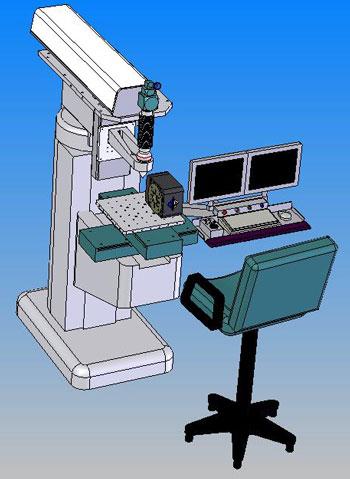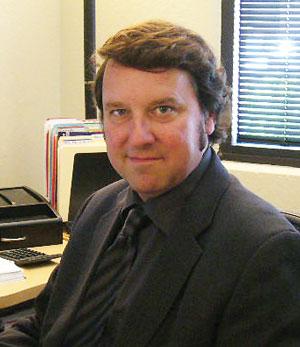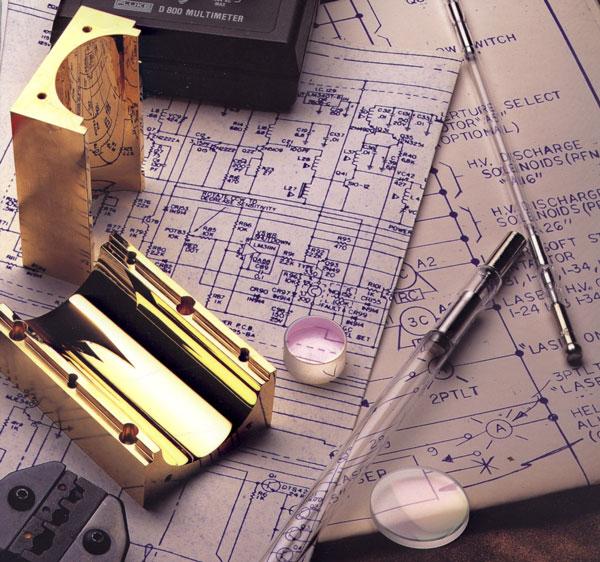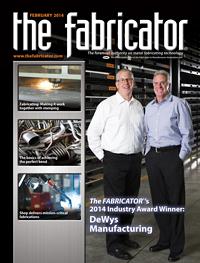Senior Editor
- FMA
- The Fabricator
- FABTECH
- Canadian Metalworking
Categories
- Additive Manufacturing
- Aluminum Welding
- Arc Welding
- Assembly and Joining
- Automation and Robotics
- Bending and Forming
- Consumables
- Cutting and Weld Prep
- Electric Vehicles
- En Español
- Finishing
- Hydroforming
- Laser Cutting
- Laser Welding
- Machining
- Manufacturing Software
- Materials Handling
- Metals/Materials
- Oxyfuel Cutting
- Plasma Cutting
- Power Tools
- Punching and Other Holemaking
- Roll Forming
- Safety
- Sawing
- Shearing
- Shop Management
- Testing and Measuring
- Tube and Pipe Fabrication
- Tube and Pipe Production
- Waterjet Cutting
Industry Directory
Webcasts
Podcasts
FAB 40
Advertise
Subscribe
Account Login
Search
Laser photonics meets shop floor pragmatism
How Directed Light carved a niche in quick-turn laser fabrication
- By Tim Heston
- February 10, 2014
- Article
- Laser Welding
Neil Ball thinks and talks fast, and for good reason. He has made a career talking with purchasing and project managers at companies like Applied Materials, Medtronic, Boeing, and Apple, and all want a prototype fabricated yesterday.
President of San Jose, Calif.-based Directed Light, Ball leads a 25-employee company. But this isn’t your everyday job shop, with a few cutting lasers feeding parts to bending, welding, and grinding. Launched 30 years ago as a laser parts supplier, Directed Light has evolved into a diverse laser prototyping and short-run production operation. Its 17 workstations span the photonics spectrum, from ultraviolet to far infrared.
UV lasers may be performing ablation. Fiber lasers may be drilling filters used in complex micro-fluidics applications in the aerospace business. Next to that, a pulsed YAG may be performing precision welds on a medical device. And next to that could be a CO2 laser cutting precision shapes in dental X-ray film.
These workstations aren’t massive or extraordinarily expensive. Ball is fascinated with some of the new ultrashort-pulse picosecond and femtosecond lasers—the latter of which pulses every 1 millionth of 1 billionth of a second and removes material atom by atom. But it wouldn’t make business sense to buy one, even though it has great potential in laser micromachining, with applications in biomedicine and high-end electronics. “An [ultrashort-pulse] laser, as amazing as it is, is extremely expensive,” Ball said. “And it’s a cycle-time pig. It takes forever.”
Pragmatism rules the day, and one workstation in particular exemplifies the shop’s character. It has the frame of an old Bridgeport mill, retrofitted with a low-power YAG laser, which may be cutting one day, precision heat-treating the next, and laser welding the following day (see Figure 1). The workstation can switch processes quickly. Here is where high technology meets some shop floor elbow grease.
Shop Roots
Ball’s roots go back to that elbow grease. With an intense gaze and rock ’n’ roll sideburns, he looks a little like Elvis, but with a productive day job. “I started sweeping the floors in this industry.”
That’s a literal statement, according to Ball, who worked in a Silicon Valley job shop several decades ago. He put together and maintained compressed- air lines. He operated a sandblasting machine, deburred parts, performed some electropolishing, and finally learned machining. Working at a job shop in the heart of Silicon Valley in the 1980s, when the personal computer came into its own, he gained experience with some high-end processing, including inert atmosphere TIG and electron beam welding. Then, in 1985, came the shop’s first laser.
“Being a young guy at the time, I saw it and thought, ‘Hey, if I learn this technology, I’ll be employable for the rest of my life,’” he said.
The CO2 laser was purchased so that the shop could cut tubular components for oscilloscopes. The job shop manager was looking for an operator to handle the laser on the swing shift, and Ball volunteered. The laser was a multiaxis system, and with Ball’s CNC machining experience, the fit made sense. “To me, it was a heck of a lot easier to program a laser than a machining center,” he said. “It was like playing with matches. You could set stuff on fire.”
Ball was only half-joking. One early job involved metal components for explosive material, and the shop had to find a way to weld the components without exploding the assembly. With its extremely narrow heat-affected zone (HAZ) and controlled heat input, laser welding fit the bill. So Ball and his team set up some blue ice and copper heat sinks, installed a protective barrier of 1-inch-thick Lexan™, and started testing. “We actually made a few of them explode,” he said.

Figure 1: This model of the company’s flexible laser station uses the frame of an old Bridgeport mill.
He worked at that first job shop for eight years, gaining experience with laser processing various parts, including some extensive work for pacemakers and defibrillators, before moving on to a large contract manufacturer that had, among other work, several government contracts. The company made inertial guidance packages, accelerometers, and other components for a variety of applications, from maverick missiles and satellites to oil drilling platforms. He loved the diverse work, but couldn’t stand the inefficiency, especially when it came to some of the government jobs. So when a job opened up at Directed Light, a small company with a fast-paced environment, Ball made the move.
One of Ball’s earliest assignments at Directed Light, laser welding medical stents, shows how the laser has evolved and, in one sense, changed perceptions as to what’s possible. Back in the 1980s, standard stent-making practice entailed laser welding wires together to form a tubular structure. Today the process starts with a tube, and a laser cuts out the stent shape, slicing through with kerf widths measured in microns.
He started at the company in systems integration, developing applications, installing machines, and training customers. He eventually moved over to sales. “I found I could talk to customers and not scare them off.” From there he became general manager and, eventually, president (see Figure 2).
When Ball took the helm, the job shop division was performing short-run production work in the aerospace and medical industries. But Ball wanted to do more. “The parts business gives us a window into the industry,” he said. “We can see if automotive is hot, or aerospace, or the medical device business.”
This gave Directed Light market intelligence that has helped it expand into various fields. The company no longer performs systems integrations, but it still operates its parts division, and its job shop division has grown significantly. On a given day, the shop may be running a laser sintering operation to repair molds or impellers for the chemical business. Next to that may be a microwelding operation for hearing aid components.
The Quick-turn Process
When a customer comes to Directed Light, Ball or another salesperson first asks the obvious question: Is the application suitable for a laser? Can the part be stacked and cut in batches? If so, perhaps wire electrical discharge machining (EDM) is the better choice. For some parts, a waterjet may be the more cost-effective process. If the laser isn’t the most cost-effective process to begin with, proceeding further would be a waste of time, both for the customer and Directed Light.
But if a job does fit the laser, the development work begins. Say a job requires a microweld seam to join two dissimilar materials. “If the materials’ melting points are close, but not too close, you actually can get a hermetic weld,” Ball said, adding that laser welding is often suitable for such dissimilar-material applications because the beam can be positioned so precisely, and the heat can be controlled.
Laser welding has a small heat-affected zone, but that HAZ is like the laser beam—tiny but with a lot of energy. “Joint cleanliness is next to godliness,” said Ball. “We’re using an intense light source, and any impurity can be very detrimental. The laser will vaporize whatever has the lowest melting point, and that can lead to cracking and porosity.” Also, the joint design should be laser weld-friendly, ideally press-fit together with no gap in between.
After initial process development, the company either continues to produce the part in-house for the customer or transfers the setup to the customer’s facility to ease the transition into production.
Top Hat Fabrication
Over the years the company has evolved into a quick-turn shop for specialized applications that often involve very small workpieces. The shop’s highest-power system is a 1-kW CO2 laser, and few applications require more than 600 W. (Though not all parts are small; for one laser sintering job, the company repairs large impellers used to mix chemicals to make pesticides.)

Figure 2: Neill Ball started at Directed Light in the systems integration division, before moving into sales, becoming general manager and, eventually, president.
These lasers can process an extremely small workpiece extremely well, but holding that workpiece steady during the laser process—be it drilling, cutting, heat treating, or welding—isn’t simple. When you’re cutting something that’s smaller than the width of a human hair, how do you hold it? Technicians have relied on vacuum chucks and various styles of parts catchers, or microtabbing the part within a larger parent material. Regardless of the method, it isn’t standard workholding.
Ball described one Boeing job that entailed a tiny, 17-4 stainless steel, top hat-shaped part with tiny holes between 0.0180 and 0.050 in. in diameter. “Imagine the Planters Mr. Peanut’s top hat and shrinking it to a rice kernel.”
The shop needed to laser-drill holes with diameters between 0.0020 and 0.0030 in. Again, the laser can drill these with no trouble, but how do you hold the part? Technicians ultimately used a tiny mandrel with reliefs machined into them to ensure it wouldn’t fuse to the workpiece during the drilling process.
Learning by Doing
To weld that tiny top hat part, technicians took only about a week to develop the process. The fast pace requires quick thinking and shop floor pragmatism. The company doesn’t employ what Ball calls “ivory tower” engineers. Instead, it looks for people who learn by doing.
Ball himself got into lasers not through academics and research, but through manufacturing—specifically, experience operating CNC machine tools. When it comes to hiring, finding the right person can be a challenge—not an unusual situation these days. The person may be trained as an engineer, but does he or she know how to work a caliper or read a micrometer? Many of the technicians that arrive at Directed Light come from hands-on environments, including California Polytechnic State University.
“The school’s motto is ‘Learn by doing,’” Ball said, adding that this approach overcomes one of the principal hurdles of the skilled-labor problem. Of course manufacturing needs smart, engaged people. That’s a given. But those people need to be engaged in shop floor realities, not software. Just because a person can draw it doesn’t mean he can make it.
Exemplifying such pragmatism is the YAG laser station retrofitted onto the base of a Bridgeport mill. Technicians stripped the head off the mill and installed a 4-axis positioning system—X, Y, and Z plus a rotary axis—to do multiaxis cutting and welding. It’s a setup that can be retooled for a different application quickly with new fixtures, laser focus spot size, and cover gas delivery. “We have versatile platforms,” Ball said. “Being a job shop, quick tooling teardown and setup is key for us to make money.”
Herein lies the challenge. Ball openly admits that the lack of available talent, even in a place as engineering-centric as Silicon Valley, continues to be its greatest challenge. The shop has hired individuals out of the medical device industry, considering the shop’s experience in that sector. “But those people are used to making a million stents,” Ball said.
“We can’t wait on tooling. If the tooling isn’t here, we have to improvise with [toggle] clamps, magnetics—even double-sided tape,” Ball said. “LEGOS® have been a new favorite tooling choice for us.”
For production work, the shop obviously uses proper custom tooling, which it contracts to have made at local machine shops. But for the initial prototype, technicians need to think fast and, perhaps most important, pragmatically. This requires the kind of thinking that Directed Light and thousands of other job shops crave.
Laser processing may be incredibly precise. But when technicians are building a prototype, the clock is ticking, and there’s no rule that says you can’t hold a part in place with LEGOS.
About the Author

Tim Heston
2135 Point Blvd
Elgin, IL 60123
815-381-1314
Tim Heston, The Fabricator's senior editor, has covered the metal fabrication industry since 1998, starting his career at the American Welding Society's Welding Journal. Since then he has covered the full range of metal fabrication processes, from stamping, bending, and cutting to grinding and polishing. He joined The Fabricator's staff in October 2007.
subscribe now

The Fabricator is North America's leading magazine for the metal forming and fabricating industry. The magazine delivers the news, technical articles, and case histories that enable fabricators to do their jobs more efficiently. The Fabricator has served the industry since 1970.
start your free subscription- Stay connected from anywhere

Easily access valuable industry resources now with full access to the digital edition of The Fabricator.

Easily access valuable industry resources now with full access to the digital edition of The Welder.

Easily access valuable industry resources now with full access to the digital edition of The Tube and Pipe Journal.
- Podcasting
- Podcast:
- The Fabricator Podcast
- Published:
- 04/16/2024
- Running Time:
- 63:29
In this episode of The Fabricator Podcast, Caleb Chamberlain, co-founder and CEO of OSH Cut, discusses his company’s...
- Industry Events
16th Annual Safety Conference
- April 30 - May 1, 2024
- Elgin,
Pipe and Tube Conference
- May 21 - 22, 2024
- Omaha, NE
World-Class Roll Forming Workshop
- June 5 - 6, 2024
- Louisville, KY
Advanced Laser Application Workshop
- June 25 - 27, 2024
- Novi, MI
































